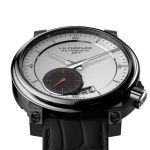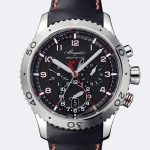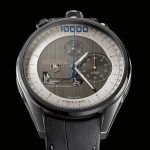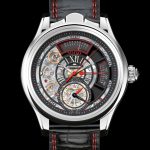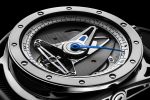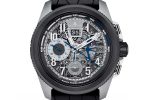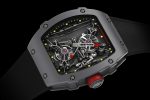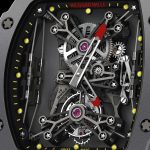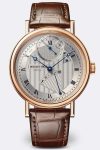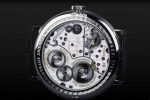Technical
State of Shock — The Extreme Edition
Technical
State of Shock — The Extreme Edition
Common sense is far from ubiquitous, however, and you’ll still come across plenty of watch owners who commit acts of heinous atrocity upon their timepieces, like this one guy I heard about who took his Vallée de Joux grande complication off-piste skiing.
On the bright side, the vast majority of watches have some form of built-in shock protection via their sprung balance endstones. Also, because movement constructors are skilled professionals who know exactly what they’re doing and can probably call on the power of Grayskull if needed, a great deal of shock resistance is also integrated with the very architecture of the watch itself — the optimum placement of gears, angles of engagement, shape and thickness of plates and bridges, all that stuff.
As a result, your watch can actually take quite a bit of a beating. I’ve been to a few watch manufactures, and one thing they like to show us is the shock testing in the quality-control department. Basically they whack a watch with a mallet, and although I’m not much of a screamer (I care about maintaining my cool exterior), you can usually read the scream in my eyes when they do that.
Now, granted, I’m not a massive sports person; probably the most strenuous activity I inflict upon my watch is when I go dancing. (And if your next question is “How strenuously can a 5ft4 girl dance?” then clearly you haven’t seen me in the club on Sunday night at Baselworld.) So I wear my watches — sports watches, dress watches — dancing, occasionally I run for a taxi, my watches get bumped around on my desk quite a lot because I type pretty violently… Your average unhealthy person’s lifestyle, basically.
What happens, however, if you’re not an average unhealthy person? What happens if you’re the kind of guy who spends his life doing Bear Grylls type shit? Or you know, you could just be some kind of hardcore athlete, I wouldn’t know, cos that stuff’s not really my bag. For an extreme kind of life, you need an extreme kind of watch. Don’t be wearing your ultra-thin 2.5Hz skeleton watch while BASE jumping, or you might as well change your name to Jon Snow cos your watch will be ended, believe me.
Quality control, the Rolex way.
One of the ways of insulating your watch against the disruptive influences of physical shock is to bump up the frequency of the balance. In principle, it’s pretty simple — Newton and his sadistic, homework-generating, schoolchild-torturing laws of motion come into play again, the ones about inertia and momentum and all that. As the frequency of the balance increases, its inertia also increases, and so does the amount of force needed to throw it off its game. In the same way, it’s much harder trying to knock a cyclist off balance when he’s going fast than when he’s going slow. (Don’t get any ideas, now. And don’t mention my name if you get caught. I got priors.)
In addition to being more resistant to an initial shock, a high-frequency balance also recovers much faster. It gets right back to business instead of sitting around feeling messed up. A high beat rate is like the Lexapro of watch oscillators.
It’s no surprise, then, that lots of sports watches feature high-frequency oscillators. Apart from the whole thing about being able to measure time with greater precision, they just stand up better to active environments. You have the OG of high-frequency integrated chronographs, the Zenith El Primero, which beats at 5Hz (36,000vph). The Chopard LUC 8HF beats at 8Hz (57,600vph) and the Breguet Type XXII soars ahead at 10Hz (72,000vph).
We haven’t even got into the TAG Heuer Mikro series of chronographs or the Montblanc Bi-Fréquence, which utilise a separate high-frequency regulator for the elapsed timing function. If there’s ever a time that you need your watch to exhibit exceptional levels of shock resistance, it’s probably during the intended use of these high-performance chronographs. Those things are fast, and I mean like Brexit-regret fast.
You think “in the blink of an eye” is just a phrase, but the fastest human blink still takes about 100ms. A single half-swing of the Mikrograph balance takes 10ms. It’s 1ms for the Mikrotimer and 0.5ms for the Mikrogirder. Most watches just want you to be good to them, but watches with high-beat escapements DGAF, they say “Come at me, bitches.”
Watch the TAG Heuer Carrera Mikros in action, side-by-side.
Shock-resistance can also be approached from another angle. Whereas the above examples boost the ability of a watch to keep on running whilst getting slammed, other watches have gone down the shock absorber route. The focus here is not so much on strengthening the movement as it is on isolating the movement and its components from shocks in the first place.
Sprung balance endstones are the most obvious form of this, and the Breguet pare-chute is based on the same principle too. Just because it was invented centuries ago doesn’t mean it doesn’t still get the job done. De Bethune, whose dedicated work on oscillators is far and away the most admirable I’ve come across in this area, are known for their use of a triple pare-chute system, which incorporates three points of shock absorption at the most vulnerable points in a watch movement — the balance staff and both ends of the balance bridge. I was going to say a bunch of other stuff about this but then I just spent the last five minutes staring at the De Bethune DB28 GS and I forgot what I was about to say next. Most likely something vaguely Orwellian and inane like “one pare-chute good, three pare-chute better”. But I can safely say that it probably wasn’t important. De Bethune watches tend to have this short-lived amnesiac effect on me. I don’t really know how to sort it out.
It’s hard to think of a better endorsement for the shock resistance of your watch than to strap it to your wrist while winning multiple tennis championships, which is what Rafael Nadal has done with his Richard Mille timepiece. The RM 27-01 has its skeletonised movement suspended in a shibari-like web of tensioned steel cables that can withstand accelerations of over 5,000G.
That may not sound like very much; after all, it’s the ISO 1413 standard for a shock-resistant watch. The human body isn’t built to take sustained acceleration, though. Death or serious injury can result from as little as 2G, depending on the direction and duration of the acceleration. Good news, your watch will still work perfectly even after you’ve succumbed to the nefarious Forces of G. Bad news, you can’t take it with you.
Those are the two main methods of protecting your watch against shock — you crank up its resilience factor or you wrap it in protective shock absorbers. Either of these methods are just as valid as the other; it’s a familiar concept for gamers trying to improve their character stats — do you choose to increase hit points or get better armour? The correct answer is: both.
The Breguet Classique Chronometrie ref. 7727 chose both. Its 10Hz balance lets the watch cruise along without worrying about low-level Gs trying to get in its way. The pare-chute is practical shock protection in action right there. And the main event, ladies and gentlemen — a self-correcting balance that maintains its position through a magnetic endstone. When the balance receives a shock and goes out of alignment, the magnetic field pulls it back into place without any mechanical contact whatsoever. When I’m feeling whimsical I like to imagine the endstone drawing the balance pivot back purely through the power of music — crooning that Coldplay song about guiding you home and fixing you.
The first time I saw this mechanism at work in an actual watch and looked at the technical drawings, I felt like doing a Jesse Pinkman. Magnets, am I right?
This technology is cool not just because of the advancements it brings to shock resistance in watchmaking — there are far-reaching consequences in the areas of tribology, mechanical efficiency and service intervals as well.
What’s important to understand here is that we’ll never be able to fully address the vulnerability of mechanical timepieces to shock, because they are, at the end of the day, physical objects governed by physical laws — and so are we. Man is seething with vulnerabilities, so why should I care if my watch skips the occasional beat when it encounters the unexpected? So does my heart.





